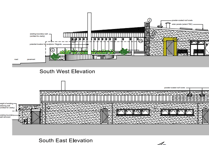The world of dog grooming is a lot more complex than you might think.
For example there’s scissoring, carding and hand-stripping; and hundreds of different breeds that require a specialist clip or trim.
And then there are some breeds that should never be clipped – many types of collie, for example – because they are double coated, and clipping would result in the hair growing back incorrectly.
This weekend’s ‘best in show’ winner at Crufts definitely needs regular grooming.
He’s a rather exotic Lagotta Romagnolo called Orca – basically, an Italian version of a springer spaniel.
He has a high maintenance coat and, although he’s classed as a gundog, it’s highly unlikely that Orca has ever run through wet and muddy undergrowth to retrieve a dead duck!
Poodles are renowned for having quite fancy haircuts, and they are purchased by many people both for their looks and because they have hypo-allergenic hair.
This lessens the likelihood that their owners will develop hayfever-like symptoms, or other such allergic reactions.
However, it you have severe allergies a poodle may still trigger symptoms because it’s not just a dog’s hair, and how much it sheds, that’s the problem.
People are usually allergic to a dog’s dander (flakes of dead skin) and/or proteins from their pet’s saliva and skin glands, and so allergens are still present no matter what the breed.
Poodle crosses (doodles) are also labelled hypo-allergenic – these types of dog include cockerpoos (we have a lot of these on the Isle of Man at the moment), labradoodles, goldendoodles and schnoodles.
Poodles and doodles are not easy breeds to maintain because their coats become easily matted from the skin outwards, leaving the topcoat looking perfectly fine.
Once this knotting starts it is very difficult to brush out, and the process can be very painful for the dog.
Ongoing maintenance at home has to be more than a quick brush once a week.
A poodle/doodle owner really needs to groom their dog’s entire coat two or three times a week, and use a technique called line brushing.
This entails brushing a small section of coat at a time, starting at the nape of the neck, and ensuring that you get right down to the roots of the hair.
Ideally your dog should be lying down so that you can groom their underbelly, or they should be on a table (a bit more tricky unless you have someone to hold them).
Problem matting ‘hot-spots’ are usually where a harness or collar rubs against the dog’s coat, behind the ears, behind the front legs where they meet the belly, and underneath the tail.
If your dog gets wet and then you leave the coat to dry naturally the mats of hair will solidify and get more difficult to brush out.
Always towel dry your poodle/doodle or, if they will allow it, use a hair dryer and then use a brush. If you plan to bathe your dog brush out any mats before they get wet.
Ideally you should start taking your puppy to a groomer from the age of about six months, so that they get used to the smells and sounds of the salon, ensuring that the grooming process doesn’t develop into a stressful one.
Most professional groomers offer a ‘puppy groom’ which is a gentle first groom to help educate the dog.
We have an adorable, and well groomed, poodle called Jet who has just arrived in our rescue kennels.
He is part of a bonded pair with his girlfriend Summer (a labradoodle), and they won’t be with us for long given the popularity of both breeds.
We always review our waiting list of ‘home finder questionnaires’ before we advertise dogs for rehoming, and so if you’re interested in dogs like Jet and Summer please complete one of these forms (which you can find on the adoption pages of our website).

-(1).jpeg?width=209&height=140&crop=209:145,smart&quality=75)



Comments
This article has no comments yet. Be the first to leave a comment.